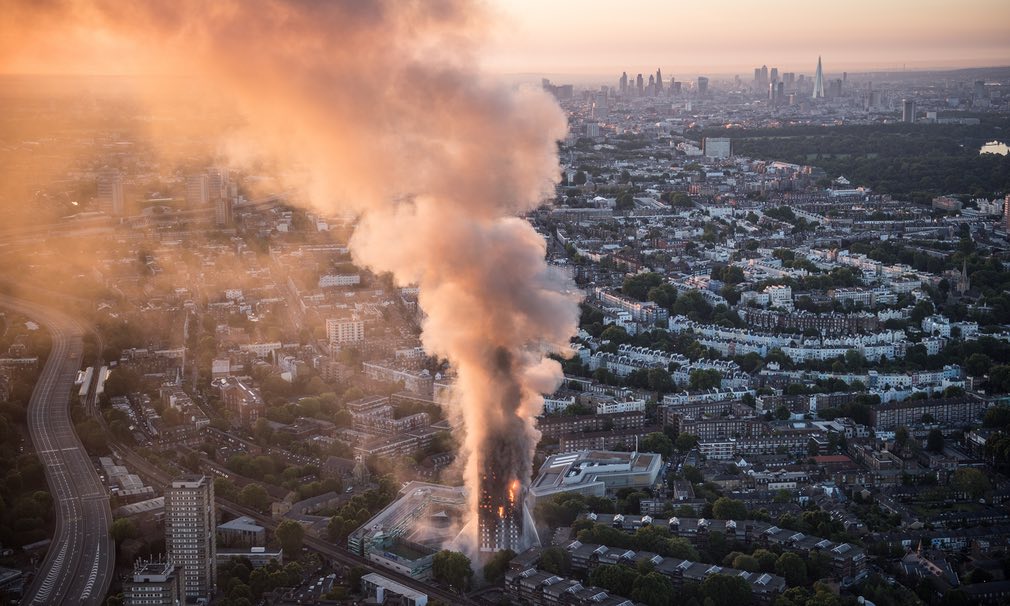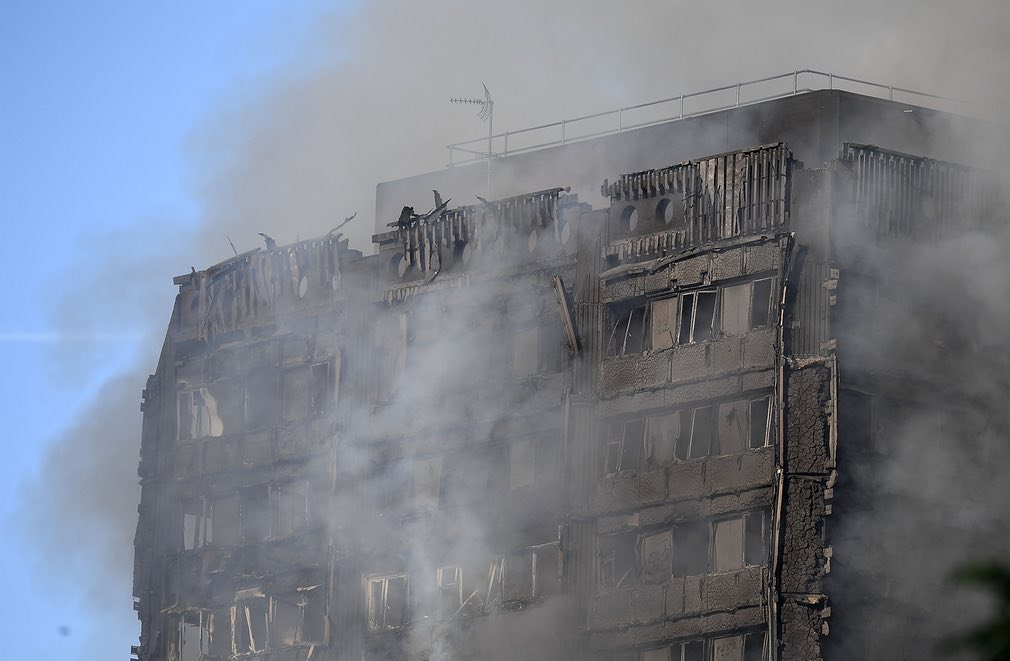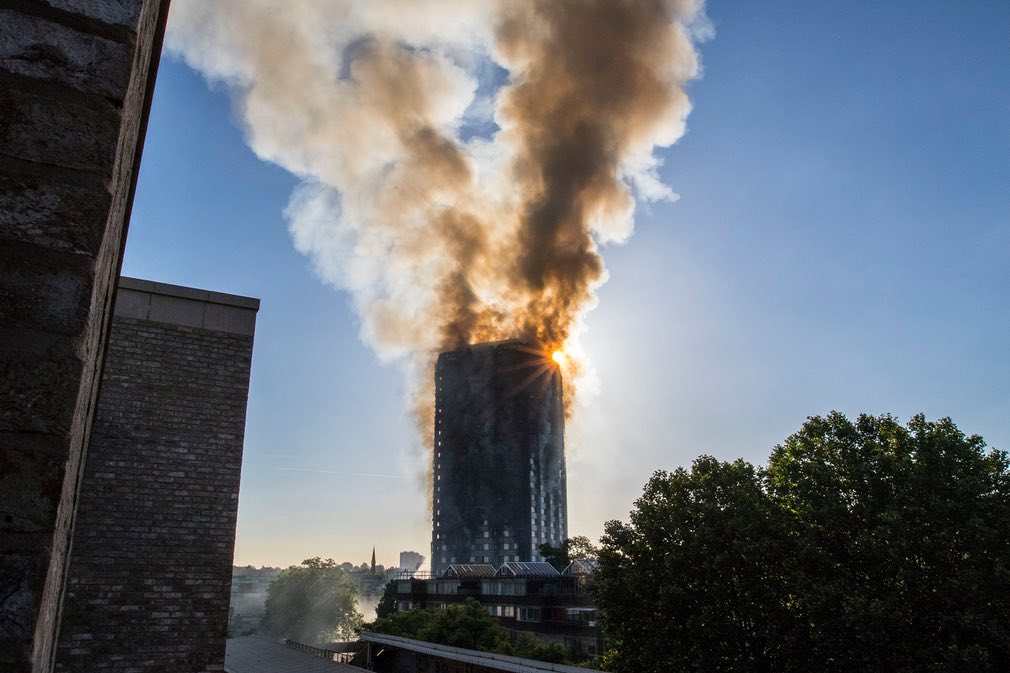Is there anything more scary than the sight of a tall building on fire? Grenfell Tower in West London was in flames all Wednesday, burning through the night like a giant torch – this is a major, major incident. Apart from the loss of life (at the moment only reporting 6 dead, but surely set to rise considerably), my guess is that this will also have effect on the building industry over there, and eventually over here too.

I don’t know about you, but some questions spring to mind pretty quickly: was the building sprinklered? If not, why not? Were there two exit stairs? Were they in fire-proof shafts? Was the alarm working? Why didn’t the building evacuate in under 4 minutes like they are meant to? Was someone working on the building who may have blocked off access to or from the stairs?

More importantly for the building industry – the tower block had just finished a 10 million pound refurbishment which included new external insulation and aluminium cladding. Off the top of my head, and without knowing anything at all about the product, I’d have to say that something about that particular insulation is very, very wrong, and it should be pulled from the market immediately. Seems clear it was one of the main means of fires leaping from floor to floor – they’ve had problems like this before – a building (or two) in Dubai also burst into flames a few years ago, on New Years eve. Not occupied, but still, the entire building was cooked. Insulation needs to be inert, not to exacerbate a fire situation.

This story will haunt the British building industry for years to come. Remember Ronan Point? This is the Ronan Point for our age.






Incredibly, in the Guardian today, with the death toll now at least 12 dead, it was confirmed that the building is unsprinklered, and only has 1 solitary escape stair, which for a 27 storey tower is appalling.
https://www.theguardian.com/uk-news/2017/jun/14/disaster-waiting-to-happen-fire-expert-slams-uk-tower-blocks
“Arnold Tarling, a chartered surveyor at Hindwoods and a fire safety expert, says the elephant in the room is the flammability of insulation panels that are being used to clad postwar buildings to bring them up to date with today’s thermal standards. A recent £8.7m refurbishment of Grenfell Tower saw the building clad with “ACM cassette rainscreen†panels, an aluminium composite material covering insulation panels, which could have caused the fire to spread more quickly up the facade of the tower.
“The issue is that, under building regulations, only the surface of the cladding has to be fire-proofed to class 0, which is about surface spread,†says Tarling. “The stuff behind it doesn’t, and it’s this which has burned.†He says he recently inspected a new-build eight storey block in south-east London where there was no fire protection in the external cavity walls. “The insulation behind the external cladding is flammable polyurethane. I know because I took a chunk out and burned it.â€
Even more appalling in my view, from the same Guardian report, is that the official advice for the Council tenants in a fire is for them to stay in their flats and not evacuate. That is just so wrong. Incredibly, it seems that they have not learned their lesson since the last major UK apartment fire. Architect Sam Webb says:
“I really don’t think the building industry understands how fire behaves in buildings and how dangerous it can be. The government’s mania for deregulation means our current safety standards just aren’t good enough.â€
“Webb advised the legal team for the families in the case of the last major tower block blaze in London, in July 2009, when a fire raged through Lakanal House, a 14-storey block built in 1958 in Camberwell, south-east London. Six people were killed, among them two children and a baby, when a fire caused by a faulty television in a ninth-floor home gutted the building.
“An inquest into the deaths found the fire spread unexpectedly fast, both laterally and vertically, trapping people in their homes, with the exterior cladding panels burning through in just four and a half minutes. As with Grenfell Tower, the official advice was for people to remain in their homes in the event of a blaze. The inquest concluded that years of botched renovations had removed fire-stopping material between flats and communal corridors, allowing a blaze to spread, and that the problem was not picked up in safety inspections carried out by Southwark council. The council was investigated over possible corporate manslaughter charges, but eventually fined £570,000 under fire safety laws.”
Grenfell tower had the same main contractor, the same cladding subcontractor and the same cladding system as a tower block refurb I worked on in East London from 2008-2011.
If they used exactly the same rainscreen system, and it looks like they did, then the insulation should have been non-combustible mineral wool, the weathering cavity would have been divided up with intumescent breaks aligning with the apartment fire cells and the cladding would have been alucobond or similar.
It was my understanding that any rainscreen system over 4 stories had to have class 0 insulation.
Looking at this photo (https://www.theguardian.com/uk-news/gallery/2017/jun/14/tower-block-blaze-in-london-in-pictures#img-1), it would appear that the insulation might be polyurethane, which I believe wasn’t permitted but might be wrong
Guy – thanks for sharing that info with us. Certainly, from the look of the smouldering wreckage, it appears that the insulation itself has provided fuel in this case – and so that would rule out mineral wool and rule in polystyrene as a likely cause. Even products like Alucobond (but I stress, NOT Alucobond) can have a combustible resin inside the aluminium cladding panels – in the case of the Dubai fire I believe it was a cause i.e. the aluminium composite cladding system itself caught fire. The people at Alucobond assured me that their product was not combustible when I asked them that question a few years ago. But I think, most likely, it is the actual insulation in the panels that is the issue.
In the case of Kingspan panels, they note on their website that :
http://www.kingspanpanels.co.nz/Fire
“Kingspan’s insulated panels are constructed from two steel faces, enclosing a proprietary fire resistant poly-isocyanurate (PIR) core. The composition of these panels is unique to Kingspan, and the manufacturing quality is unsurpassed.” and also that “Kingspan Firesafe systems have been tested and approved to Factory Mutual (FM 4880, FM 4881) and Loss Prevention Certification Board (LPCB), standards to comply with property insurers risk requirements. To comply with FM, LPCB, fire test standards no flash over or fire propagation occurs. No flame spread occurs within the panel core. Kingspan Firesafe roof and wall systems are secured to the main/secondary frame of the building to protect fire fighters.”
On another Guardian link, https://www.theguardian.com/uk-news/2017/jun/14/stay-put-safety-advice-under-scrutiny-grenfell-tower-fire there is an interesting quote –
“Mike Tobin, the technical director of Security and Fire Experts Ltd in Bury, Greater Manchester, said: “As a rule, the ‘stay put’ policy works but I think this is such a tragic incident there’s so many potential issues that make it a one-off.â€
Tobin said the “stay put†policy was the long and short of advice to residents in tower blocks and that it was for someone “far higher than my pay grade†to decide whether it should be reviewed.
He described the inferno as a game-changer for the fire safety industry. “I’ve never seen anything like this,†he said. “This will change our industry whether we like it or not. There’s too many deaths for it to go without something coming out of it. They might look at what Scotland is doing, putting sprinklers in all new communal buildings, but that would not have stopped this fire.â€
A senior firefighter in the north-west of England, who did not want to be named, said he had never seen anything like it in his 32 years in the fire service. He said it was so “out of the ordinary and as yet not understoodâ€.
“Conventional wisdom may not fit this scenario,†he said.
The tangled web of companies involved in this project, all now running for cover.
https://www.theguardian.com/uk-news/2017/jun/15/long-builder-chain-for-grenfell-a-safety-and-accountability-issue?
Thomas Lane, editor of Building Design, said: “There was a time when local authorities had their own architecture departments, some of them quite famous. Nowadays it’s all done externally. You’ve got disparate people, design teams, surveyors, project managers, a whole army of people.â€
Ben Bradford, a fire safety expert who is managing director of the risk consultancy BB7, said the multiple links in the chain of contractors could cause safety problems. “There’s probably multiple failings that have occurred in this particular case,†he said. “The work, in terms of fire stopping, often falls to a sub-contractor. They don’t always realise the critical nature of the components they’re installing in the overall system.â€
He also claimed that the partial privatisation of the building inspection regime sometimes led to a “race to the bottom†to reduce fees and limit the number of safety inspections carried out.
I’m going to link some websites up here with interesting information about this.
https://www.thecanary.co/2017/06/23/weve-been-investigating-evidence-grenfell-found-numbing/
That one, the Canary, has further links to other information.
Here is a Building Consent application to demolish the tower – back in 2014
https://www.rbkc.gov.uk/bconline/propertyDetails.do?activeTab=relatedCases&keyVal=_RBKC_PROPLPI_35504_1
Metro (the UK rag, not the Auckland mag) says this:
http://metro.co.uk/2017/06/21/grenfell-tower-refurbishment-was-never-formally-signed-off-6723671/
as well as this:
http://metro.co.uk/2017/06/23/grenfell-tower-insulation-and-tiles-failed-all-safety-tests-police-confirm-6729208/